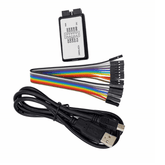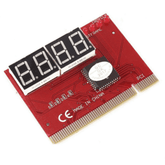DC Motor Applications
What is DC Motor?
DC Motor converts electrical energy to mechanical energy using DC or Direct Current power supply.
A DC motor works based on Fleming’s Left-Hand Rule, which says that a current-carrying wire in a magnetic field experiences a force. In the motor, the rotating armature cuts through magnetic lines, creating a back EMF (a voltage that opposes the input voltage). This back EMF helps the motor regulate itself.
When the load on the motor increases, its speed decreases, and then the back EMF reduces. This allows more current to flow and increasing torque to handle the load. When the load falls, the motor speeds up, the back EMF increases, and the current decreases. This causes the motor to automatically adjust to function efficiently under varying loads.
Also, check out this blog - Speed control of a DC motor.
Types of DC Motors
The type of motor used in a particular application depends on the characteristic of the dc motor.
Depending on the desired characteristics i.e. mechanical requirements of the applied load, torque characteristics (for example different motors are distinguished by the torque generated when the motor starts and the torque produced when it's running at rated speed) different motors are used in different applications.
There are mainly 9 types of DC Motors, such as:
Permanent Magnet DC Motor (PMDC Motor):
By adding a permanent magnet, this system makes a magnetic field without needing another part called a field winding. This way, it doesn't have to use a separate field winding, making the operation more efficient and straightforward. The permanent magnet simplifies the whole system, avoiding the complications of having a separate field winding.
This creative setup not only improves how the system works but also marks a big step forward compared to traditional setups that need a separate field winding to create a magnetic field.
Shunt Wound DC Motor:
In this setup, a parallel or shunt winding is closely connected to the armature, making sure there's a steady field current even if the armature current changes. This design is crucial for keeping the system's electrical operations stable and consistent. With the parallel or shunt winding, the system effectively lessens the effect of armature current changes, making sure the field current stays reliable and constant.
This smart connection between the winding and armature shows how the system can maintain a steady flow of electrical energy, making it more efficient and reliable in its performance.
Compound Wound DC Motor:
This motor brings together features from both series and shunt wound motors by including both series and parallel field windings in its design. This unique setup combines the strengths of series-wound motors for strong torque and shunt-wound motors for steady speed control.
Having both series and parallel field windings makes the motor versatile, allowing it to adapt to different operational needs. This engineering approach optimizes the motor's performance, taking advantage of the best features from both series and shunt winding configurations.
Series Wound DC Motor:
Including a series configuration means intentionally positioning the field winding along with the armature winding. This purposeful arrangement is made to allow electrical current to flow through both the field winding and the armature winding at the same time.
This connected setup is important to ensure a synchronized and coordinated flow of current, creating a smooth interaction between the field and armature parts. By directing the current through both windings, this configuration improves the motor's performance, making it more efficient and functional. The intentional use of series winding principles highlights a careful engineering approach to achieve a seamless and integrated electrical operation.
Separately Excited DC Motor:
With separate power sources for the field winding and armature winding, this system allows independent control of field and armature currents. Having distinct power supplies ensures precise and autonomous regulation of the electrical currents in the field and armature windings.
This design permits accurate adjustments and customization of the field and armature currents, offering a higher level of control over the motor's performance. The intentional separation of power sources demonstrates an advanced engineering strategy, enabling fine-tuned management of the system's key components and enhancing its versatility and adaptability in operation.
Self Excited DC Motor:
The motor's operation relies on the electromagnetism it naturally produces. This self-generated electromagnetism is crucial for creating the necessary magnetic field that the motor needs to work. By having electric currents and magnetic forces interact within the motor, this self-sustaining process continuously generates and maintains the required magnetic field.
Depending on its internal electromagnetism showcases a self-contained and efficient mechanism, demonstrating self-sufficiency that enhances the motor's reliability. The intricate connection between electricity and magnetism in the motor highlights a fundamental principle in electromechanical systems, ensuring a steady and self-sustained magnetic field for optimal performance.
Long Shunt DC Motor:
This motor falls into the compound motor category, specifically identified as a compound motor with a shunt winding connected in parallel to the armature on both the load side and the supply side.
In this setup, the shunt winding is closely linked in parallel to the armature, creating a dual connection on both the load side and the supply side of the motor. This design improves the motor's versatility by blending the benefits of both series and shunt winding configurations, resulting in a balanced performance in terms of torque, speed regulation, and overall operational efficiency.
Short Shunt DC Motor:
This motor is categorized as a compound motor and has a specific setup where the shunt winding is connected in parallel to the armature but only on the load side. In this design, the parallel connection between the shunt winding and the armature happens exclusively on the load side of the motor.
This design decision impacts the motor's performance, providing a customized balance between the benefits of series and shunt winding configurations, especially in terms of torque, speed regulation, and overall operational efficiency. The deliberate parallel connection on the load side highlights a thoughtful approach to fine-tuning the motor's functionality for specific application needs.
Differential Compound DC Motor:
This motor uses a mix of cumulatively compounded and differentially compounded winding setups to achieve specific performance goals. By combining both cumulative and differential winding principles, the motor fine-tunes its operational features, customizing torque, speed regulation, and overall efficiency to meet specific performance needs.
This dual winding approach provides precise control over the motor's behavior, balancing cumulative and differential effects to achieve desired outcomes in terms of power, stability, and adaptability to different loads. The blend of these winding techniques showcases an advanced engineering strategy aimed at adjusting the motor's performance for specific applications.
What are the applications of DC Motor?
DC motors are one of the most versatile and widely used machines in modern engineering. Their rugged construction, reliable performance, and easy maintenance make them ideal for a wide range of DC motor applications such as:
- Automotive Industries
- Hoists & Cranes operations
- Industrial tools power supply
- Lifts
- Air compressor
- Winching system
- Elevators
- Electric traction

In the manufacturing industry DC motors find various purposes like
- Drilling machine
- Driving fan operation
- Printing presses,
- Controlling conveyor belts,
- Operating food processors
- And more.
DC Motors also uses in home electronics products such as
- Hair drier
- Vacuum cleaners and speed regulation application
- power tools
- Sewing machines
- Electric footing
Increasing demand for automation has furthered their usage across many sectors due to its fast response time of up to 100 MS even at higher speeds which is not possible with other competing technologies existing today.
This factor also makes it an attractive choice when quick movements need precise control over motor speed or torque direction must be reversed frequently - including robotics arm movement where longer life cycle expectations come into play as well thereby making these dc machines much near perfect solutions.
Also, read our blog on the Working of AC Motors detailing what AC motors, construction, and working of AC motors, the types of AC motors, and their working principle.
Application of Permanent Magnet DC Motor
In this type of motor, there is no field winding around the stator instead a permanent magnet is used to produce magnetic flux. Hence it only has armature connections and no field windings since there is a stator and no field winding.
Following are the applications:
- AIR conditioners.
- Computer drives
- Electric toothbrushes
- Portable vacuum cleaners. Drilling machines, trimmers, etc.
- Food mixers
- drones

They are used where a small motor is required and no speed control is necessary.
Applications of DC series motor
Used where high starting torque is needed, variation of speed is required they are not fit for constant speed.
DC series motor uses are:
- Vacuum cleaner
- Traction systems
- Sewing machines
- Cranes
- Air compressors.
In this type of motor field winding is present and is connected in series with the armature winding as shown in the figure

(Note: You can neglect the resistance R rheostat in the figure it's just here so that we will be able to limit the current through the field winding. So the general figure of shunt and compound would consist without the Rheostat R.)
Applications of Shunt Motor
In this type of motor field winding is present and is connected in parallel(that's why called a shunt) with the armature winding as shown in the figure.
- Centrifugal pumps
- Weaving and lathe machines
- Lifts
- Fans
- Blowers
- Spinning machines
- Conveyors
They are used where constant/stable speed is required irrespective of the load.
Application of Compound Motor
This motor consists of both shunt and series field winding. They can be started at no load, unlike dc motors. They are categorized into two types:
Cumulative compound motor:
It comes with a high starting torque and has satisfactory speed regulation at fast speeds.
Uses of Cumulative compound motor:
- Presses
- Shears
- Conveyors
- Elevators
- Rolling mills
- Heavy planners.
Used where high starting torque and almost constant speed are needed.
Explore motor for project, (Motors & Mechanical section for project-worthy motors, including DC motors, stepper motors, and servo motors).
Differential compound DC motor
In differential motor, the series field opposes the shunt field. It has low starting torque as net flux is minimized by this opposition. Its flux reduces sharply for the small increase in load at higher values of load. This decrease in flux causes the starting torque to be less than any other DC motor. They are not used much for practical applications.
Conclusion
In this blog post, we have learned DC motors have an incredibly diverse range of applications across numerous industries. Whether it's the efficiency of the permanent magnet DC motor or the high torque of the DC series motor, each type offers unique advantages that can be utilized for specific tasks. From shunt motors used in industrial machines to compound motors powering electric vehicles, DC motors play a critical role in many aspects of modern life. And if you need the best of both worlds, the differential compound DC motor is there to provide unmatched performance. So whether you're a student of electrical engineering or a professional in the field, it's clear that understanding the applications of DC motors is key to unlocking their full potential.
If you understand the DC motor applications and appreciate our work don't forget to share this post and leave your opinion in the comment box.
Please do check out other blog posts about Popular Electronics
Make sure you check out our wide range of products and collections (we offer some exciting deals!)






